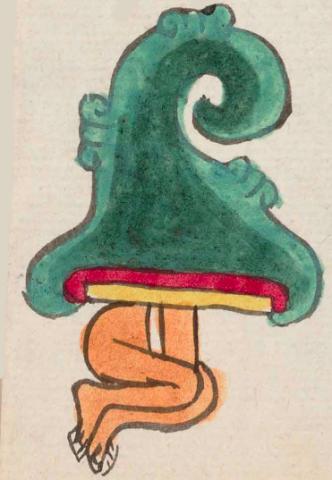Colhuatzinco (Mdz20r)
This compound glyph for the place name Colhuatzinco has two principal elements, a mountain with a twisted top (colli) and a lower, male body facing to the viewer's right and emphasizing the rear end or buttocks (tzintli), providing the phonetic element for the locative suffix -tzinco (little, lower, or new place). The hill or mountain is somewhat bell shaped, as is usual, with the exception that the peak curls to the right. The base of the mountain has the typical, horizontal, yellow and red stripes. The human body is nude with the exception of a loincloth, but we can only see the white waist band or belt of the loincloth. The knees are bent.
Stephanie Wood
Colhua could be interpreted as people with ancestors, but this is also what the people of Colhuacan were called. The shape of the mountain recalls the glyph for Culhuacan, which supports the interpretation that this glyph refers to a "New Culhuacan," as suggested by Frances Karttunen. Whittaker favors "Little [Place]" or "Lower [Place}." Sometimes -tzin is a reverential.
Stephanie Wood
colhuaçinco.puo
Colhuatzinco, pueblo
Stephanie Wood
c. 1541, or by 1553 at the latest
Stephanie Wood
hills, mountains, cerros, montañas, Culhuacan, Culhuatzinco, nombres de lugares

Colhua, people of Colhuacan, https://nahuatl.wired-humanities.org/content/Colhua
Colhuacan, a place name, https://nahuatl.wired-humanities.org/content/Colhuacan
coltic, curved, https://nahuatl.wired-humanities.org/content/coltic
-hua- (possessor suffix for nouns), https://nahuatl.wired-humanities.org/content/hua
-tzinco (locative suffix), little, lower, or new (place), https://nahuatl.wired-humanities.org/content/tzinco
-tzin (reverential suffix), https://nahuatl.wired-humanities.org/content/tzin
"New Colhuacan" [Frances Karttunen, unpublished manuscript, used here with her permission.]
"On the Little Place of the Colhua" (Berdan and Anawalt, 1992, vol. 1, p. 180)
"Nuevo Culhuacan"
Stephanie Wood
Codex Mendoza, folio 20 recto, https://digital.bodleian.ox.ac.uk/objects/2fea788e-2aa2-4f08-b6d9-648c00..., image 50 of 188.
The Bodleian Libraries, University of Oxford, hold the original manuscript, the MS. Arch. Selden. A. 1. This image is published here under the UK Creative Commons, “Attribution-NonCommercial-ShareAlike 3.0 License” (CC-BY-NC-SA 3.0).




